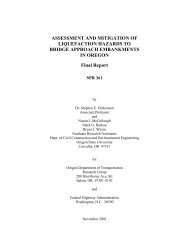Oregon Balance of State HIV/AIDS Housing & Services Systems ...
Oregon Balance of State HIV/AIDS Housing & Services Systems ...
Oregon Balance of State HIV/AIDS Housing & Services Systems ...
You also want an ePaper? Increase the reach of your titles
YUMPU automatically turns print PDFs into web optimized ePapers that Google loves.
<strong>Oregon</strong> <strong>HIV</strong>/<strong>AIDS</strong> <strong>Housing</strong> and <strong>Services</strong> <strong>Systems</strong> Integration Plan 41<br />
Critical Issues<br />
This section summarizes critical issues that need to be addressed to ensure integration between<br />
<strong>HIV</strong>/<strong>AIDS</strong> housing and services and other systems, as developed by the <strong>Oregon</strong> <strong>HIV</strong> <strong>Housing</strong> and<br />
Service <strong>Systems</strong> Integration Plan Steering Committee.<br />
The <strong>Oregon</strong> <strong>HIV</strong> <strong>Housing</strong> and Service <strong>Systems</strong> Integration Plan Steering Committee met in Salem,<br />
<strong>Oregon</strong>, on December 18, 2007, to review findings from the assessment <strong>of</strong> <strong>HIV</strong>/<strong>AIDS</strong> resources and<br />
systems integration conducted by Building Changes during the second half <strong>of</strong> 2007. Based on these<br />
findings, the Committee identified critical issues in systems integration that pose challenges to<br />
meeting the housing and related needs <strong>of</strong> people living with <strong>HIV</strong> and <strong>AIDS</strong> in the state <strong>of</strong> <strong>Oregon</strong><br />
(outside <strong>of</strong> the Portland Metropolitan Area).<br />
The Committee identified both general issues related to the outreach and partnership strategies <strong>of</strong><br />
the <strong>Oregon</strong> <strong>Housing</strong> Opportunities in Partnership (OHOP) program, and issues specific to the<br />
various housing and service systems which should be involved in an integrated <strong>HIV</strong> housing and<br />
service plan for <strong>Oregon</strong> residents. These issues are described below and divided into two categories:<br />
Outreach and Partnership Development, and Integration with <strong>Housing</strong> and Service <strong>Systems</strong>.<br />
Outreach and Partnership Development<br />
1. Limited Awareness <strong>of</strong> Resources Dedicated to People Living with <strong>HIV</strong>/<strong>AIDS</strong><br />
Steering Committee members noted that many mainstream housing and services partners, all<br />
potential OHOP partners, lack awareness or accurate knowledge <strong>of</strong> the OHOP program. This lack<br />
<strong>of</strong> awareness <strong>of</strong> existing <strong>HIV</strong>/<strong>AIDS</strong> resources likely extends to the greater community, including<br />
among faith- and other community-based organizations, and may limit partnerships in several ways.<br />
Potential housing partners may not be familiar with the <strong>Oregon</strong> Department <strong>of</strong> Human <strong>Services</strong>,<br />
Public Health, <strong>HIV</strong>/STD/TB Section, <strong>HIV</strong> Care and Treatment program, and thus might not<br />
recognize the availability <strong>of</strong> service match dollars or other partnership opportunities. For instance,<br />
providers may have misconceptions about the flexibility <strong>of</strong> DHS <strong>HIV</strong> Care and Treatment dollars to<br />
leverage housing funds. Because services administered by <strong>HIV</strong> Care and Treatment are supported<br />
by a blend <strong>of</strong> state, federal, and revenue funds, they can be used as a service match for federal<br />
housing programs such as HOME Tenant-Based Assistance, unlike federal Ryan White funding<br />
alone.<br />
In addition, some agencies use limited resources when those services could be covered by a<br />
dedicated funding stream for clients with an <strong>HIV</strong> diagnosis. For example, both the OHOP program<br />
and Community Action Agencies (CAAs) <strong>of</strong>fer emergency utility assistance. CAAs that do not<br />
have or share information about OHOP with their clients may end up spending out their utility<br />
assistance funds on OHOP-eligible clients, while OHOP funds remain underutilized.<br />
In addition, some government departments and agencies that are unfamiliar with OHOP and the<br />
<strong>HIV</strong> Care and Treatment Program do not keep OHOP staff and <strong>HIV</strong> Care and Treatment Program

















